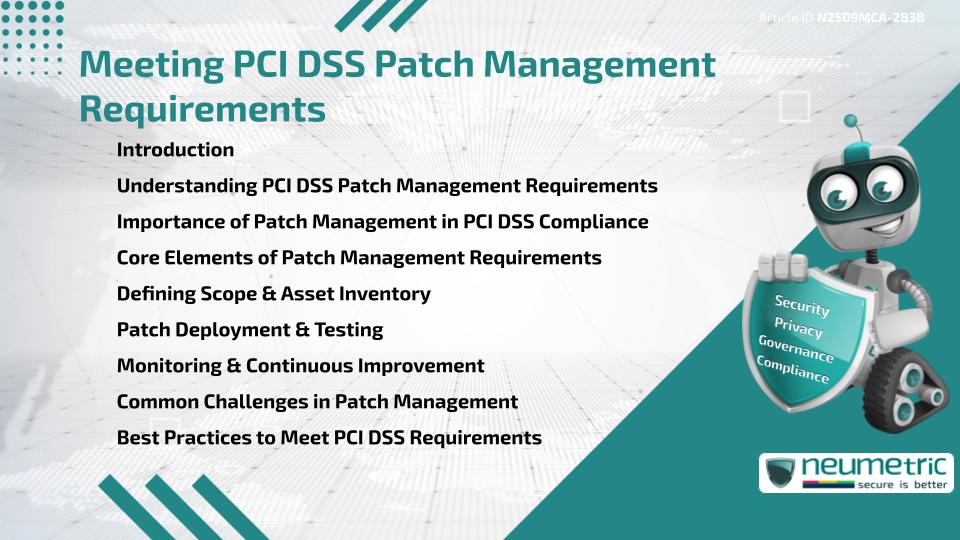Table of Contents
ToggleIntroduction
The PCI DSS Patch Management requirements play a crucial role in protecting Cardholder Data & ensuring compliance with the Payment Card Industry Data Security Standard [PCI DSS]. Effective Patch Management helps close Vulnerabilities, prevent Security Breaches & maintain trust with Clients & Partners. This article explains the key requirements, challenges & Best Practices for achieving compliance.
Understanding PCI DSS Patch Management Requirements
Under PCI DSS, Patch Management is mandated to ensure that all systems handling Cardholder Data are protected against known Vulnerabilities. The PCI DSS Patch Management requirements emphasise timely installation of Vendor-supplied security patches & ongoing monitoring to reduce the Risk of exploitation.
Importance of Patch Management in PCI DSS Compliance
Patch Management is not optional-it is a compliance obligation. Without timely updates, systems remain exposed to Cybersecurity Threats. Meeting PCI DSS Patch Management requirements helps organisations prevent data breaches, avoid fines & maintain compliance during audits.
Core Elements of Patch Management Requirements
Key aspects of PCI DSS Patch Management requirements include:
- Establishing & maintaining an asset inventory
- Applying Vendor security patches within one (1) month of release
- Testing patches in controlled environments before deployment
- Documenting patch deployment activities
- Monitoring systems to confirm successful implementation
Defining Scope & Asset Inventory
Organisations must first define scope by identifying all Systems & Data that fall under PCI DSS. Creating a detailed asset inventory ensures that no component handling Cardholder Data is overlooked during the patching process.
Patch Deployment & Testing
Before deploying patches, enterprises should test them in controlled environments to avoid disruptions. Once validated, patches must be applied across relevant systems within required timelines. Documentation of patch deployment is critical for demonstrating compliance.
Monitoring & Continuous Improvement
Meeting PCI DSS Patch Management requirements involves ongoing monitoring of patch status. Automated tools can provide real-time insights & alerts. Continuous Monitoring & Improvement ensures that Vulnerabilities are addressed promptly & compliance is sustained.
Common Challenges in Patch Management
Enterprises often face challenges such as:
- Large numbers of systems to patch
- Limited maintenance windows
- Resource Constraints
- Compatibility issues during testing
These challenges highlight the importance of strong planning & automated Patch Management solutions.
Best Practices to Meet PCI DSS Requirements
To comply with PCI DSS Patch Management requirements, organisations should:
- Maintain an up-to-date asset inventory
- Use automated Patch Management tools
- Establish clear Policies for patch deployment
- Conduct regular Internal & External Audits
- Schedule Management Review Meetings for oversight
These practices simplify compliance & strengthen security posture.
Takeaways
- The PCI DSS Patch Management requirements ensure timely Vulnerability remediation
- Asset inventories & documentation are critical for compliance
- Testing patches before deployment avoids disruptions
- Continuous Monitoring & Improvement sustains compliance
- Automation & regular Audits support stronger Patch Management
FAQ
What are PCI DSS Patch Management requirements?
They are mandates under PCI DSS to ensure timely patching of systems handling Cardholder Data.
Why are PCI DSS Patch Management requirements important?
They protect against Vulnerabilities, reduce Security Threats & ensure compliance with PCI DSS.
How quickly must patches be applied under PCI DSS Patch Management requirements?
Patches must typically be applied within one (1) month of release.
What Evidence is needed for PCI DSS Patch Management requirements?
Evidence includes asset inventories, patch testing records, deployment logs & monitoring reports.
What challenges exist in meeting PCI DSS Patch Management requirements?
Challenges include resource limitations, compatibility issues & maintaining patch schedules.
How can enterprises simplify PCI DSS Patch Management requirements?
By using automation, clear Policies & regular Audits to ensure timely patching.
Do Small Businesses need to follow PCI DSS Patch Management requirements?
Yes, any business handling Cardholder Data must comply with these requirements, regardless of size.
Need help for Security, Privacy, Governance & VAPT?
Neumetric provides organisations the necessary help to achieve their Cybersecurity, Compliance, Governance, Privacy, Certifications & Pentesting needs.
Organisations & Businesses, specifically those which provide SaaS & AI Solutions in the Fintech, BFSI & other regulated sectors, usually need a Cybersecurity Partner for meeting & maintaining the ongoing Security & Privacy needs & requirements of their Enterprise Clients & Privacy conscious Customers.
SOC 2, ISO 27001, ISO 42001, NIST, HIPAA, HECVAT, EU GDPR are some of the Frameworks that are served by Fusion – a SaaS, multimodular, multitenant, centralised, automated, Cybersecurity & Compliance Management system.
Neumetric also provides Expert Services for technical security which covers VAPT for Web Applications, APIs, iOS & Android Mobile Apps, Security Testing for AWS & other Cloud Environments & Cloud Infrastructure & other similar scopes.
Reach out to us by Email or filling out the Contact Form…


